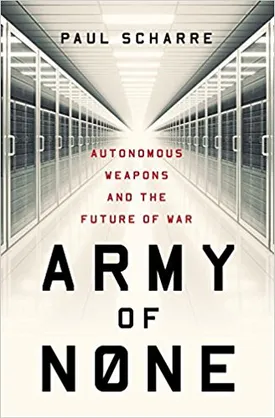Army of None: Autonomous Weapons and the Future of War by Paul Scharre
Army of None: Autonomous Weapons and the Future of War, written by Paul Scharre, is an important and timely book to consider as autonomous weapons, technologies and weapons systems, become increasingly prevalent in the military and law enforcement operations around the globe. Scharre, a esteemed senior fellow with the Center for a New American Security, explores the policy and legal questions, geopolitical dynamics and ethical considerations surrounding the development and use of these weapons. He argues that our current laws and regulations are not sufficient to govern the use of autonomous weapons, and he examines what new rules and regulations will be needed to ensure that such systems are used responsibly and ethically. He provides a comprehensive analysis of current lethal autonomous weapons systems (LAWs) and suggests how we can create a “Guardians of Life” approach to ensure that autonomous weapons are used responsibly.
The book begins with a comprehensive and clear explanation of the various forms of autonomous weapons, the differences between them, and the policy and legal implications surrounding their use. Scharre examines the difference between LAWs and semi-autonomous weapons, and explains why some military robots such as drones are considered to be semi-autonomous, rather than fully autonomous. He also provides an overview of the range of current LAWs, including the terminal- Guided Missile (TGM), the Perdix swarm, and the SGR-A2 sentry gun. Scharre argues that LAWs have both positive potential, such as being able to detect and respond to threats more rapidly than humans, and negative potential, such as increasing the risk of miscalculation and accidental attacks.
With the increasing use of LAWs and other autonomous weapons, Scharre calls for setting clear moral, ethical and legal boundaries to their use. He argues that it is essential to ensure that autonomous weapons are held to the same or higher level of accountability as conventional arms, and he suggests a new “guards of life” framework that would ensure that LAWs are used as only a last resort and with stringent rules of engagement and strict protocols. Scharre outlines three lines of responsibility: meaningful human control of autonomous weapons, accountability to ensure that those using LAWs are held responsible for any potential damage that their system might cause, and transparency and oversight to ensure that the public has an understanding of the implications of their use.
Scharre takes a comprehensive look at the policy, legal, ethical and practical challenges associated with the use of autonomous weapons, and this makes the book an important read for those in the military, law enforcement and anyone else with an interest in the current and future use of these systems. Scharre is also careful to bring in the voices of those who are advocating for a ban on automated lethal weapons, to ensure that their arguments and concerns are addressed. Moreover, in addition to ethical and legal considerations, Scharre also highlights the economic, geopolitical and geostrategic implications of the development of LAWs.
Overall, Army of None: Autonomous Weapons and the Future of War is a comprehensive and thought-provoking exploration of autonomous weapons, their implications and their potential effects on the future of war. Scharre provides a well-researched and balanced examination of the various perspectives on this issue, and he offers a convincing argument for the need for a “guards of life” framework that would ensure that autonomous weapons are used responsibly and ethically. This book provides essential reading for anyone who is interested in the current state of autonomous weapons and the implications of their continued development. It is especially relevant for those in the military, law enforcement and policy-making circles.

